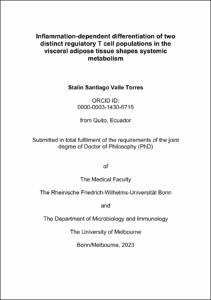Valle Torres, Stalin Santiago: Inflammation-dependent differentiation of two distinct regulatory T cell populations in the visceral adipose tissue shapes systemic metabolism. - Bonn, 2023. - Dissertation, Rheinische Friedrich-Wilhelms-Universität Bonn, University of Melbourne.
Online-Ausgabe in bonndoc: https://nbn-resolving.org/urn:nbn:de:hbz:5-73239
Online-Ausgabe in bonndoc: https://nbn-resolving.org/urn:nbn:de:hbz:5-73239
@phdthesis{handle:20.500.11811/11166,
urn: https://nbn-resolving.org/urn:nbn:de:hbz:5-73239,
author = {{Stalin Santiago Valle Torres}},
title = {Inflammation-dependent differentiation of two distinct regulatory T cell populations in the visceral adipose tissue shapes systemic metabolism},
school = {{Rheinische Friedrich-Wilhelms-Universität Bonn} and {University of Melbourne}},
year = 2023,
month = dec,
note = {Visceral adipose tissue (VAT) is an endocrine organ critical for energy storage and metabolic homeostasis. It harbours a plethora of immune cells, which play an important role in maintaining tissue homeostasis. A large body of work has shown that type 2 immune cells including T helper (TH2) cells, type 2 innate lymphoid cells (ILC2) and anti-inflammatory macrophages are associated with a healthy VAT and metabolic state. On the other hand, infiltration of inflammatory immune cells, such as CD8+ T cells, pro-inflammatory macrophages, and TH1 cells, result in type 1 inflammation and ultimately lead to insulin resistance and development of metabolic disease.
Foxp3+ regulatory T (Treg) cells are critical to restrain VAT inflammation and preserve glucose tolerance. We and others have previously demonstrated that VAT Treg cells are dependent on the adipogenesis transcription factor PPAR? and the cytokine IL-33 for their differentiation and maintenance. Further, we have shown that VAT Treg cells display sexual dimorphism on a cellular and transcriptional level. These differences are orchestrated by IL-33 and sex hormones that underpin VAT inflammation and metabolic phenotype. How precisely VAT inflammation and microenvironment shape Treg cell differentiation and function in males and females, however, is still insufficiently known. Here we uncover that the VAT harbours two distinct Treg cell populations, prototypical ST2+ Treg cells, that are enriched in males and depend on IL-33 and PPARγ, and a previously uncharacterized population of VAT Treg cells that express the chemokine receptor CXCR3, are enriched in females and depend on the transcription factor T-bet and cytokine IFN-γ. We also reveal that the transcription factor GATA3 promoted differentiation of ST2+ VAT Treg cells and together with PPARγ and IL-33 repressed the differentiation of CXCR3+ Treg cells. We further show that CXCR3+ VAT Treg cells developed from naïve Treg cells in a cytokine IFN-g dependent manner. Finally, we demonstrate that ST2+ Treg cells controlled blood glucose levels, while CXCR3+ Treg cells limited VAT inflammation. Overall, this study establishes the developmental trajectories of two molecularly and functionally distinct Treg cell types in the VAT that act in a sex-specific manner.},
url = {https://hdl.handle.net/20.500.11811/11166}
}
urn: https://nbn-resolving.org/urn:nbn:de:hbz:5-73239,
author = {{Stalin Santiago Valle Torres}},
title = {Inflammation-dependent differentiation of two distinct regulatory T cell populations in the visceral adipose tissue shapes systemic metabolism},
school = {{Rheinische Friedrich-Wilhelms-Universität Bonn} and {University of Melbourne}},
year = 2023,
month = dec,
note = {Visceral adipose tissue (VAT) is an endocrine organ critical for energy storage and metabolic homeostasis. It harbours a plethora of immune cells, which play an important role in maintaining tissue homeostasis. A large body of work has shown that type 2 immune cells including T helper (TH2) cells, type 2 innate lymphoid cells (ILC2) and anti-inflammatory macrophages are associated with a healthy VAT and metabolic state. On the other hand, infiltration of inflammatory immune cells, such as CD8+ T cells, pro-inflammatory macrophages, and TH1 cells, result in type 1 inflammation and ultimately lead to insulin resistance and development of metabolic disease.
Foxp3+ regulatory T (Treg) cells are critical to restrain VAT inflammation and preserve glucose tolerance. We and others have previously demonstrated that VAT Treg cells are dependent on the adipogenesis transcription factor PPAR? and the cytokine IL-33 for their differentiation and maintenance. Further, we have shown that VAT Treg cells display sexual dimorphism on a cellular and transcriptional level. These differences are orchestrated by IL-33 and sex hormones that underpin VAT inflammation and metabolic phenotype. How precisely VAT inflammation and microenvironment shape Treg cell differentiation and function in males and females, however, is still insufficiently known. Here we uncover that the VAT harbours two distinct Treg cell populations, prototypical ST2+ Treg cells, that are enriched in males and depend on IL-33 and PPARγ, and a previously uncharacterized population of VAT Treg cells that express the chemokine receptor CXCR3, are enriched in females and depend on the transcription factor T-bet and cytokine IFN-γ. We also reveal that the transcription factor GATA3 promoted differentiation of ST2+ VAT Treg cells and together with PPARγ and IL-33 repressed the differentiation of CXCR3+ Treg cells. We further show that CXCR3+ VAT Treg cells developed from naïve Treg cells in a cytokine IFN-g dependent manner. Finally, we demonstrate that ST2+ Treg cells controlled blood glucose levels, while CXCR3+ Treg cells limited VAT inflammation. Overall, this study establishes the developmental trajectories of two molecularly and functionally distinct Treg cell types in the VAT that act in a sex-specific manner.},
url = {https://hdl.handle.net/20.500.11811/11166}
}






